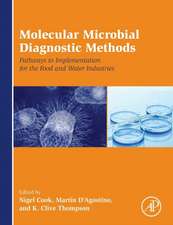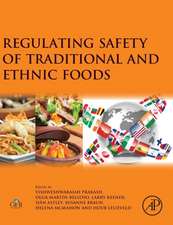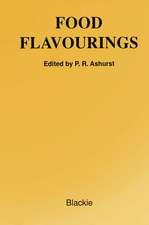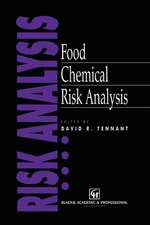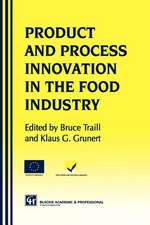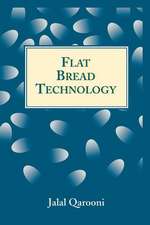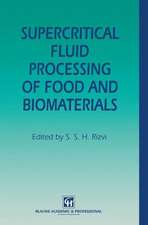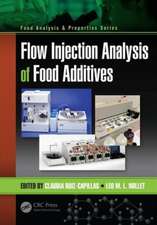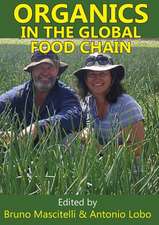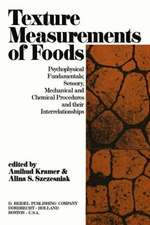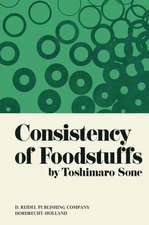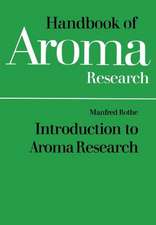Saffron: Science, Technology and Health
Editat de Alireza Koocheki, Mohammad Khajeh-Hosseinien Limba Engleză Paperback – 16 ian 2020
Intended for nutrition scientists and scientists and technologists working in the areas of food, agriculture, new product development and pharmacology.
- Summarizes the scientific, technical and health aspects of saffron
- Explores the use of saffron in the conventional food industry in the development of new products
- Uncovers the unique agronomical, ecological, social and physiological characteristics of saffron
Preț: 1217.02 lei
Preț vechi: 1676.18 lei
-27% Nou
Puncte Express: 1826
Preț estimativ în valută:
232.91€ • 242.26$ • 192.28£
232.91€ • 242.26$ • 192.28£
Carte tipărită la comandă
Livrare economică 07-21 aprilie
Preluare comenzi: 021 569.72.76
Specificații
ISBN-13: 9780128186381
ISBN-10: 0128186380
Pagini: 580
Ilustrații: Approx. 300 illustrations
Dimensiuni: 216 x 276 x 34 mm
Greutate: 1.3 kg
Editura: ELSEVIER SCIENCE
ISBN-10: 0128186380
Pagini: 580
Ilustrații: Approx. 300 illustrations
Dimensiuni: 216 x 276 x 34 mm
Greutate: 1.3 kg
Editura: ELSEVIER SCIENCE
Public țintă
Nutrition scientists and scientists and technologists working in the areas of food, agriculture, new product development, and pharmacologyCuprins
Section One: Cultural and Social Aspects of Saffron
1. Saffron and Folklore
2. Saffron and Religions
3. Saffron in the Ancient History of Iran
Section Two: Saffron Production
4. Evolution, Botanical and Agricultural Characteristics of Saffron (Crocus sativus L.) and Related Species
5. Soil Conditions for Sustainable Saffron Production
6. Water Requirement of Saffron
7. Saffron Seeds- The Corm
8. Advances in Modeling Saffron Growth and Development at Different Scales
9. Saffron Crop Protection
10. Ecophysiology of Saffron
11. Emerging Innovation in Saffron
Section Three: Genetics and Biotechnology of Saffron
12. Molecular Biology and Genetics of Crocus sativus L.
13. Tissue and Cell Culture of Saffron
14. Secondary Metabolites in Saffron
Section Four: Saffron Processing
15. Dehydration of Saffron Stigmas
16. Assessment and Monitoring of Saffron Microbiological Criteria
17. Saffron Adulteration
Section Five: Economy and Trade of Saffron
18. Saffron Cultivation: An Economic Analysis
19. Saffron Marketing: Challenges and Opportunities
20. Environmental-Economic Analysis of Saffron Production with the Emphasis of Energy, Environmental Impacts and Ecosystem Functions
Section Six: Saffron and Health
21. History of Saffron in Medicine
22. Phytochemistry of Saffron
23. Saffron in Traditional Medicine
24. The Effectiveness of Saffron (Crocus sativus L.) on Memory Function, Learning Ability and Epilepsy
25. Antidepressant and Antianxiety Properties of Saffron
26. Saffron (Crocus sativus L.) and its Constituents; their Anti-Inflammatory and Immunomodulatory Effects
27. Cardiovascular Effects of Saffron and its Active Constituents
28. Saffron (Crocus sativus L.) and its Main Constituents, their Effect on Respiratory System
29. Saffron in Metabolic Disorders
30. Available Saffron Formulations and Patents
1. Saffron and Folklore
2. Saffron and Religions
3. Saffron in the Ancient History of Iran
Section Two: Saffron Production
4. Evolution, Botanical and Agricultural Characteristics of Saffron (Crocus sativus L.) and Related Species
5. Soil Conditions for Sustainable Saffron Production
6. Water Requirement of Saffron
7. Saffron Seeds- The Corm
8. Advances in Modeling Saffron Growth and Development at Different Scales
9. Saffron Crop Protection
10. Ecophysiology of Saffron
11. Emerging Innovation in Saffron
Section Three: Genetics and Biotechnology of Saffron
12. Molecular Biology and Genetics of Crocus sativus L.
13. Tissue and Cell Culture of Saffron
14. Secondary Metabolites in Saffron
Section Four: Saffron Processing
15. Dehydration of Saffron Stigmas
16. Assessment and Monitoring of Saffron Microbiological Criteria
17. Saffron Adulteration
Section Five: Economy and Trade of Saffron
18. Saffron Cultivation: An Economic Analysis
19. Saffron Marketing: Challenges and Opportunities
20. Environmental-Economic Analysis of Saffron Production with the Emphasis of Energy, Environmental Impacts and Ecosystem Functions
Section Six: Saffron and Health
21. History of Saffron in Medicine
22. Phytochemistry of Saffron
23. Saffron in Traditional Medicine
24. The Effectiveness of Saffron (Crocus sativus L.) on Memory Function, Learning Ability and Epilepsy
25. Antidepressant and Antianxiety Properties of Saffron
26. Saffron (Crocus sativus L.) and its Constituents; their Anti-Inflammatory and Immunomodulatory Effects
27. Cardiovascular Effects of Saffron and its Active Constituents
28. Saffron (Crocus sativus L.) and its Main Constituents, their Effect on Respiratory System
29. Saffron in Metabolic Disorders
30. Available Saffron Formulations and Patents

